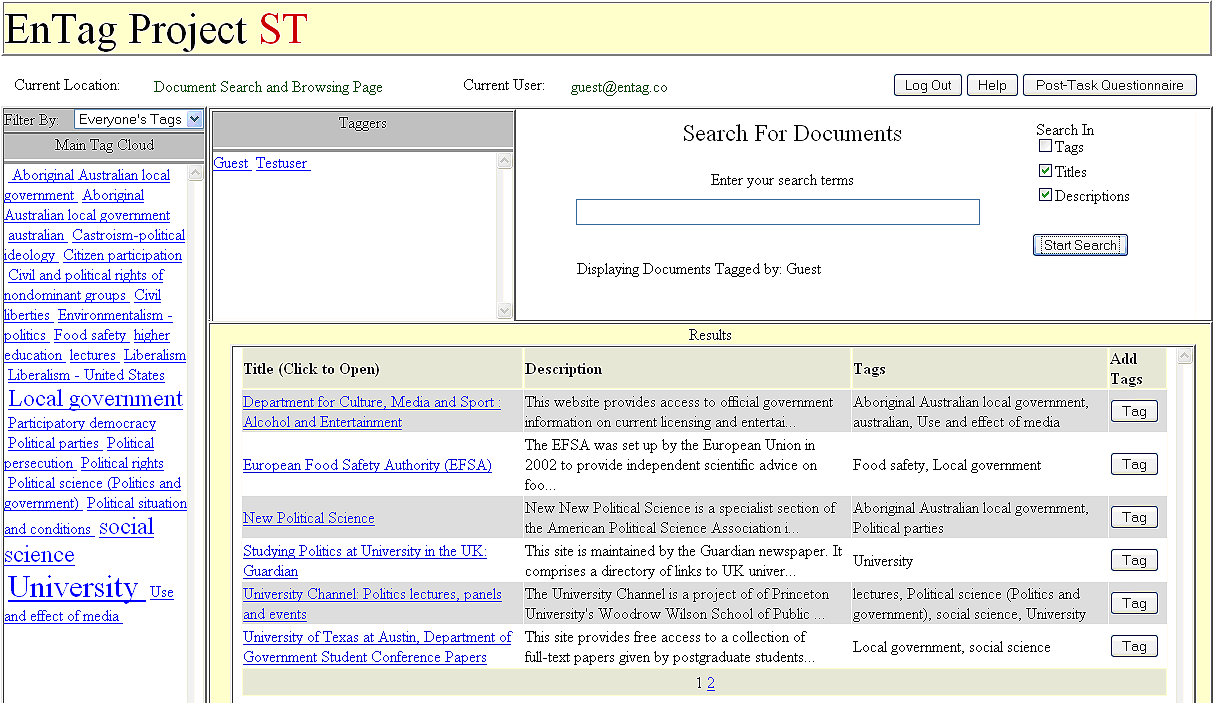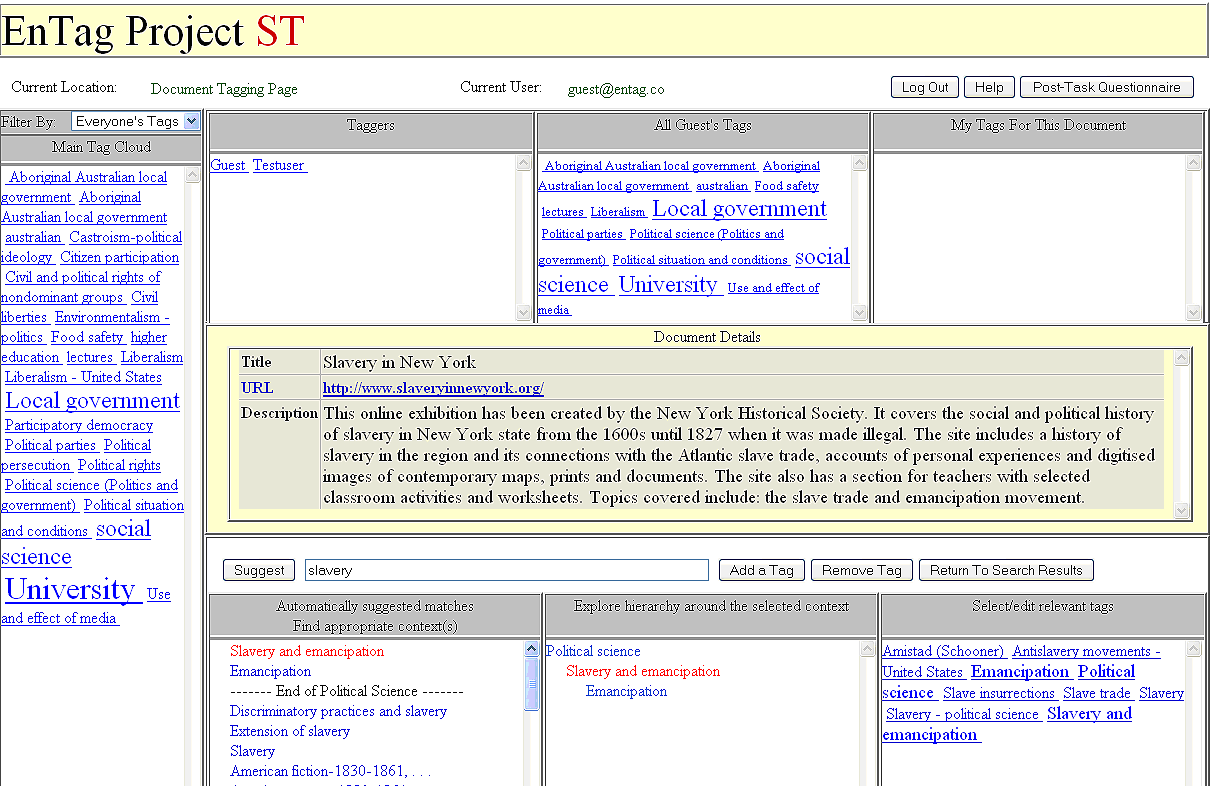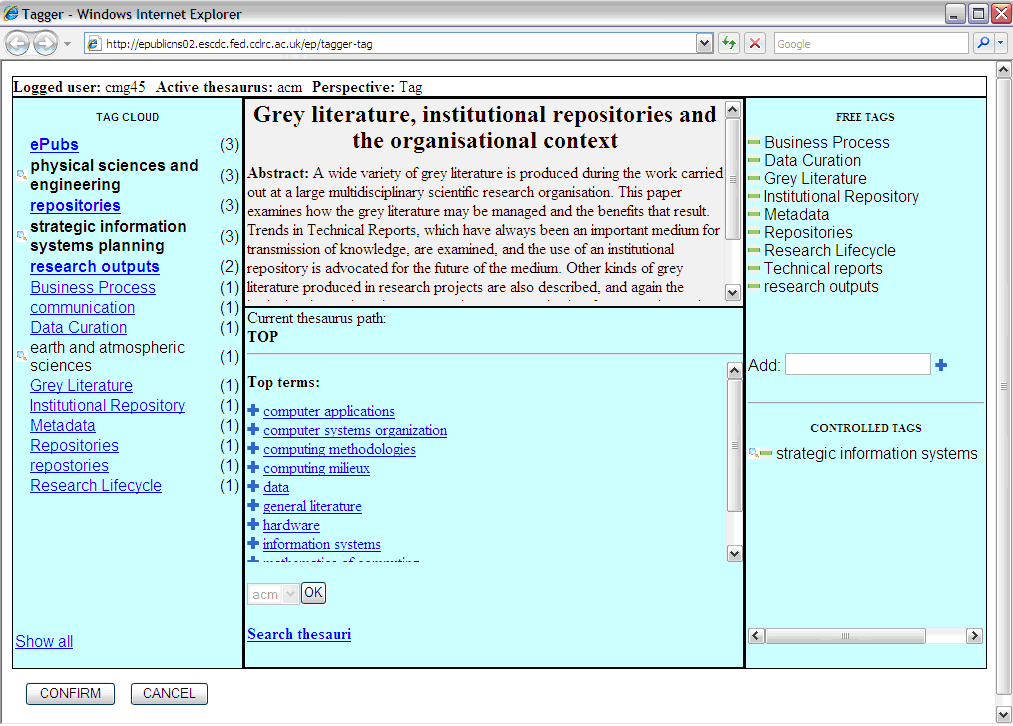Enhanced Tagging for Discovery (EnTag)
Demonstrators
1) Intute demonstrator
The Intute demonstrator includes accessing Dewey Decimal Classification (DDC). Different options for linking DDC to social tagging are provided. Search system for purposes of illustrating search scenarios is also designed. The demonstrator is now available, the main output being the Enhanced Tagger. Please consult the settings document for help with the hardware and software requirements and the training document for help with using the demonstrator.
The Intute demonstrator comprises three major interfaces: searching,
simple tagging, and enhanced tagging. Once a person logs in, he/she
arrives to the searching interface (Figure 1). The searching interface
provides the following features:
1) Main Tag Cloud: a tag cloud with tags linked to
documents to which they were assigned. It is an alphabetical list of
all tags in the demonstrator, with different font sizes relative to
popularity. Filter By drop-down menu on top offers the My Tags option
which presents the current taggers’s tags only. By default everyone’s
tags are shown (Everyone’s Tags).
2) Taggers: a cloud of names of taggers linked to documents
they indexed.
3) A free-text search box, with an option to limit
searching to tags, title and description fields.
The documents found are shown in the Results pane. They are automatically
ranked according to the MySQL full-text natural language search. Title,
description (from Intute) and existing tags are shown here. By clicking
on the Title, the URL opens in a new window.

Figure 1. Intute demonstrator’s searching interface
Once a document is selected from search results, clicking on the “Tag”
button will return a tagging interface. Here title, URL, and description
are displayed. Two tagging interfaces are provided: 1) the Simple Tagger,
with tagging features common in popular social tagging applications;
and 2) the Enhanced Tagger, with additional suggestions from the controlled
vocabulary. (In the study the log-on screen provides the choice of the
interfaces). Both tagging interfaces have the following options from
which to select tags (Figure 2):
1) Main Tag Cloud.
2) Taggers: names of taggers linked to tags they have
used, the latter listed in the All {Tagger Name}’s Tags pane; and,
3) My Tags For This Document.
By clicking on a selected tag, the tag will be shown in the text box.
By pressing the Tag Document button the tag will be added to the document
as well as listed in the “My Tags for This Document” pane. A tag can
also be typed in.
Enhanced Tagger (Figure 2) additionally provides suggestions from the
controlled vocabulary, presented in three panes at the bottom of the
screen. In the first pane to the left (“Automatically suggested matches,
Find appropriate context(s)”), DDC classes are listed. They are automatically
derived by a string-matching comparison of DDC vocabulary to a user-entered
term from the text box above the panes upon clicking the Suggest button.
Immediately after the user comes to the enhanced tagging page, initial
suggestions are automatically generated by treating the document’s title
as if it had been entered as a tag.
If the user clicks on one of the listed classes from the first pane,
its narrower and broader classes are shown in the second pane (“Explore
hierarchy around the selected context”), allowing interactive browsing
of the hierarchical context. Simultaneously, in the third pane (“Select/edit
relevant tags”) a tag-cloud-like list of DDC captions, DDC relative
index terms and LCSH mapped terms is presented as a source of suggestions
from which the user may select a tag. Selecting a tag copies it to the
text box, where it can be further edited; pressing the Tag Document
button adds the tag to the document.

Figure 2. Intute demonstrator’s enhanced tagging interface
2) STFC demonstrator
The STFC demonstrator is based on extended current author tagging system of the STFC ePublication Archive along social tagging lines.
The Tagger interface is supplied in conjunction with the ePubs metadata editing tool so that tags can be entered for a specific publication by its authors. The figure below shows a screen shot of a typical tagging screen.

Figure 3. STFC interface.
The screen is divided into four main areas:
1) At the top-centre, the title and abstract of the
publication selected for tagging are displayed.
2) At the bottom-centre, a browse interface for the
controlled vocabulary is shown. Initially top-level terms are shown.
Clicking on a term will show its narrower and related terms. The current
path to the top of the hierarchy is always shown as a ‘breadcrumb’ trail
along the top of the hierarchy. Terms can be selected as tags by clicking
on the “+” symbol to the left of each term. Apart from browsing the
controlled vocabulary, one can also search it (the “Search thesauri”
link).
3) To the left a tag cloud is displayed, with tags
ranked in order of descending use frequency. They can be selected by
either clicking on them (if they are free-text terms) or clicking on
the spyglass symbol to their left (if they are from the controlled vocabulary).
This will enter them into the “Add” term box to the right of the screen,
where they can be accepted as a tag for the paper. The tag cloud as
a default shows the terms used by the current author. “Show all” will
display all authors’ tags.
4) To the right, the current selected free-text (top)
and controlled vocabulary terms (bottom) are shown. They can be deselected
by clicking on the “—” sign to their left. In the centre of the panel,
there is a free-text box, where the user can enter free-text terms.
Multiple terms can be entered by separating them with commas.
Once a suitable selection of tags has been made using the tool, the
user can accept them by clicking on the “Confirm” button at the bottom
of the screen.
The ACM Computing Classification
Scheme was the chosen controlled vocabulary. Since its main purpose
is to classify papers which are submitted to various ACM journals, it
has a widespread awareness and authority within the computing community.
It was first imported into SKOS
and then into the tool.
The STFC demonstrator is an Apache Cocoon application using combined
Java and XML techniques, the underlying database being Oracle. It links
dynamically to the STFC ePubs institutional
repository so that once the user performs a search in the repository,
in a specially adapted edit mode there is an option to enter the Tagger
system. Once the system is started, the title and abstract of the work
are transferred together with any existing free tags.
Currently the Demonstrator is behind the STFC firewall and is not publically
available. STFC are considering whether to develop the system further
for use in within the ePubs production system.